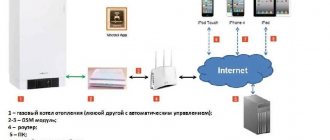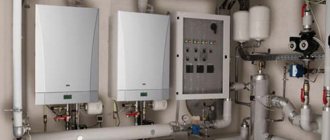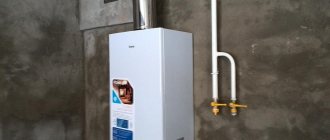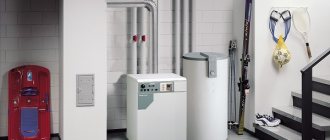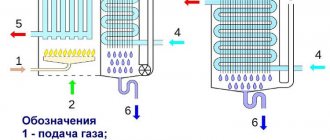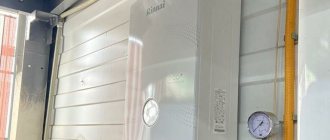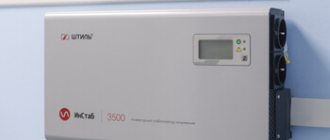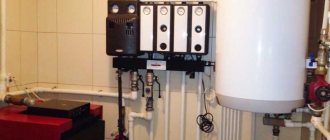Factors affecting boiler operation
They are:
- Design. The equipment may have 1 or 2 circuits. It can be mounted on a wall or on the floor.
- Normative and actual efficiency.
- Proper heating arrangement. The power of the equipment is comparable to the area that needs to be heated.
- Technical conditions of the boiler.
- Gas quality.
Question about the design.
The device may have 1 or 2 circuits. The first option is complemented by an indirect heating boiler. The second one already has everything you need. And the key mode in it is the provision of hot water. When water is supplied, heating ends.
Models mounted on the wall have less power than those placed on the floor. And they can heat a maximum of 300 sq.m. If your living space is larger, you will need a floor-mounted unit.
P.2 efficiency factors.
The document for each boiler reflects the standard parameter: 92-95%. For condensation modifications it is approximately 108%. But the actual parameter is usually 9-10% lower. It decreases even more due to heat losses. Their list:
- Physical underburning. The reason is excess air in the apparatus when gas is burned, and the temperature of the exhaust gases. The larger they are, the more modest the efficiency of the boiler.
- Chemical underburning. What is important here is the volume of CO2 oxide produced when carbon is burned. Heat is lost through the walls of the apparatus.
Methods for increasing the actual efficiency of a boiler:
- Removing soot from pipelines.
- Elimination of scale from the water circuit.
- Limit chimney draft.
- Adjust the position of the blower door so that the coolant reaches its maximum temperature.
- Removing soot from the combustion compartment.
- Installation of a coaxial chimney.
P.3 Questions about heating. As already noted, the power of the device necessarily correlates with the heating area. A competent calculation is needed. The specifics of the structure and potential heat losses are taken into account. It is better to entrust the calculation to a professional.
If the house is built according to building codes, the formula works: 100 W per 1 sq.m. This results in a table like this:
| Area (sq.m.) | Power. | ||
| Minimum | Maximum | Minimum | Maximum |
| 60 | 200 | 25 | |
| 200 | 300 | 25 | 35 |
| 300 | 600 | 35 | 60 |
| 600 | 1200 | 60 | 100 |
It is better to purchase foreign-made boilers. Also in advanced versions there are many useful options that help you achieve the optimal mode. One way or another, the optimal power of the device is in the spectrum of 70-75% of the highest value.
The optimal operating mode of a gas boiler to save gas is achieved by eliminating clocking. That is, you need to set the gas supply to the lowest value. The attached instructions will help with this.
Adjustment
Automatic control is provided by the heating regulator.
It includes the following parts:
- Computing and matching panel.
- Actuating device on the water supply section.
- An actuator that performs the function of mixing liquid from the returned liquid (return).
- Boost pump and sensor on the water supply line.
- Three sensors (on the return line, on the street, inside the building). There may be several of them in the room.
The regulator closes the liquid supply, thereby increasing the value between return and supply to the value specified by the sensors.
To increase the flow, there is a boost pump and a corresponding command from the regulator. The incoming flow is controlled by a "cold bypass". That is, the temperature decreases. Some of the liquid that has circulated along the circuit is sent to the supply.
Sensors collect information and transmit it to control units, resulting in a redistribution of flows that provide a rigid temperature scheme for the heating system.
Sometimes, a computing device is used that combines hot water and heating regulators.
The hot water regulator has a simpler control scheme. The hot water sensor regulates the flow of water with a stable value of 50°C.
Advantages of the regulator:
- The temperature scheme is strictly maintained.
- Elimination of overheating of the liquid.
- Fuel and energy efficiency.
- The consumer, regardless of the distance, receives heat equally.
What you need to know about collectors?
This design ensures a uniform supply of liquid to several simultaneously switched on water taps while maintaining the required pressure. When selecting equipment, you should remember that there are manifolds for distributing cold and hot water.
To make the device body, brass or stainless steel is used; there are devices made of impact-resistant plastic that can withstand heating to temperatures of more than 100°C. Metal products are attached to pipelines using threaded bushings. To connect plastic pipelines, manifolds with compression transition elements or with special bushings (fittings) are used that allow plastic pipes to be soldered.
When selecting a collector, you should take into account the number of outputs intended for switching external equipment. Standard products provide up to 6 channels, but manufacturers allow 2-3 collector modules to be connected in series. For coupling, couplings are provided at the nodes; the method of connection depends on the design features of the collector. If switching of the additional unit is not required, the collector is closed with an end cap.
Recommendations for the buyer
Basic recommendations for selecting a collector:
- Before purchasing a collector, you should decide on the type of material of the water pipes. It is recommended to use products made of polymers (for example, cross-linked polyethylene) that are not destroyed by water and do not have threaded connections.
- During the installation process, it is necessary to provide for the installation of a tap for the side lines. There are manifold blocks with integrated valves; the installer needs to connect the pipes and the manifold itself to the central riser. Please note that if the locking mechanism is damaged, the entire manifold block will need to be replaced. When using brass or stainless steel products, the taps must be installed separately.
- A block of additional devices is installed in front of the manifold (for example, meters, filters or a check valve).
Table with temperature graph
The operating mode of boilers depends on the environmental weather.
If we take various objects, for example, a factory building, a multi-storey building and a private house, they will all have an individual thermal diagram.
In the table we show the temperature diagram of the dependence of residential buildings on outside air:
| Outdoor temperature | Temperature of network water in the supply pipeline | Return water temperature |
| +10 | 70 | 55 |
| +9 | 70 | 54 |
| +8 | 70 | 53 |
| +7 | 70 | 52 |
| +6 | 70 | 51 |
| +5 | 70 | 50 |
| +4 | 70 | 49 |
| +3 | 70 | 48 |
| +2 | 70 | 47 |
| +1 | 70 | 46 |
| 70 | 45 | |
| -1 | 72 | 46 |
| -2 | 74 | 47 |
| -3 | 76 | 48 |
| -4 | 79 | 49 |
| -5 | 81 | 50 |
| -6 | 84 | 51 |
| -7 | 86 | 52 |
| -8 | 89 | 53 |
| -9 | 91 | 54 |
| -10 | 93 | 55 |
| -11 | 96 | 56 |
| -12 | 98 | 57 |
| -13 | 100 | 58 |
| -14 | 103 | 59 |
| -15 | 105 | 60 |
| -16 | 107 | 61 |
| -17 | 110 | 62 |
| -18 | 112 | 63 |
| -19 | 114 | 64 |
| -20 | 116 | 65 |
| -21 | 119 | 66 |
| -22 | 121 | 66 |
| -23 | 123 | 67 |
| -24 | 126 | 68 |
| -25 | 128 | 69 |
| -26 | 130 | 70 |
There are certain standards that must be observed in the creation of projects for heating networks and the transportation of hot water to the consumer, where the supply of water steam must be carried out at 400°C, at a pressure of 6.3 Bar. It is recommended that the heat supply from the source be released to the consumer with values of 90/70 °C or 115/70 °C.
Regulatory requirements must be met in compliance with the approved documentation with mandatory approval from the Ministry of Construction of the country.
Link to download the chart
- 110 - for industrial premises of categories B, D and D with emissions of flammable dust and aerosols;
- 130 - for industrial premises without the release of flammable dust and aerosols.
The maximum temperature, °C, of the heating surface should be taken as follows:
- c) for low-temperature panels for radiant heating of workplaces - 60.
- d) for high-temperature radiant heating devices - 250.
- e) for building structures with built-in heating elements:
- — 26 — for floors of rooms with constant occupancy;
- — 30 — for bypass paths, benches of swimming pools;
- — 31 — for floors of premises with temporary occupancy;
- - 28, 30, 33, 36, 38 for ceilings with a room height not exceeding 2.8, 3.0, 3.5, 4 and 6 m, respectively.
What happens when hot water is turned on simultaneously at two points of intake
The scheme becomes more complicated if, while using hot water at one point of intake, it becomes necessary to turn it on at another point, for example: when the shower is turned on in the bathroom, it becomes necessary to wash your hands in the toilet washbasin. In this case:
- the rate of hot water use increases sharply, its consumption increases,
- weak pressure of hot water appears;
- the flow of cold water into the boiler increases,
- a drop in the temperature of the boiler heat exchanger leads to the fact that the water temperature at the first intake point ceases to be comfortable,
- a few seconds are required to turn on the boiler automation for heating,
- a few more seconds for both users at two points of collection to be able to use water at a comfortable temperature.
All this time, both users cannot fully use hot water. It arrives intermittently. The unproductive consumption of water, which goes uselessly into the sewer system, increases sharply.
What if one of the users turned off the water? In this case, the consumption of hot water drops sharply. A temperature jump occurs on the heater of a double-circuit gas boiler. As a result, the temperature of hot water increases sharply at the point of intake that continues to operate. The user cannot fully use the water; it goes down the drain until the automation on the boiler is activated and water at the required temperature begins to flow to the user in a stable manner.
Since such situations are repeated several times every day, the unproductive consumption of hot water increases every day. At the same time, we should not forget about the discomfort that users experience when the supply of hot water is unstable.
DHW circuit with storage heater (boiler) and water circulation
A storage water heater (boiler) is a heat-insulated metal tank of a fairly large volume.
Most often, two heaters are built into the lower part of the water heater tank at once - an electric heating element and a tubular heat exchanger connected to the heating boiler (diagram for connecting the boiler to the boiler). The water in the tank is heated by the boiler most of the time.
The electric heater is turned on as needed when the boiler is stopped. Such a boiler is often called an indirect heating boiler.
Hot water in an indirect heating boiler is consumed from the top of the tank. In its place, cold water from the water supply immediately enters the lower part of the tank, is heated by a heat exchanger and rises upward.
In the European Union, hot water systems in new houses are required to be equipped with a solar heater - a collector. To connect the solar collector, another heat exchanger is installed in the lower part of the indirect heating boiler .
The water in the boiler is heated by a solar collector. If there is not enough heat from the collector, then the boiler or electric heater is switched on. Read: “DHW system with solar collector” .
Heating system water temperature
- In the corner room +20°C;
- In the kitchen +18°C;
- In the bathroom +25°C;
- In corridors and stairwells +16°C;
- In the elevator +5°C;
- In the basement +4°C;
- In the attic +4°C.
It should be taken into account that these temperature standards refer to the heating season and do not apply to the rest of the time. Also, it will be useful information that hot water should be from +50°C to +70°C, according to SNiP-u 2.08.01.89 “Residential buildings”. There are several types of heating systems: Contents
- 1 With natural circulation
- 2 With forced circulation
- 3 Calculation of the optimal temperature of the heating device 3.1 Cast iron radiators
- 3.2 Aluminum radiators
- 3.3 Steel radiators
- 3.4 Warm floor
With natural circulation The coolant circulates without interruption.
Coordination of coolant and boiler temperatures
Regulators help coordinate the temperature of the coolant and the boiler.
These are devices that create automatic control and adjustment of return and supply temperatures. The return temperature depends on the amount of liquid passing through it. Regulators cover the liquid supply and increase the difference between the return and supply to the level required, and the necessary indicators are installed on the sensor.
If the flow needs to be increased, a boost pump can be added to the network, which is controlled by a regulator. To reduce the heating of the supply, a “cold start” is used: that part of the liquid that has passed through the network is again transported from the return to the inlet.
The regulator redistributes the supply and return flows according to the data collected by the sensor, and ensures strict temperature standards for the heating network.
Use a recirculation pump
The best option is that the water heater is located in close proximity to the hot water intake points. The closer it is, the faster the hot water enters the tap, the more efficiently it is used. If this option for installing a water heater is not possible, then it is recommended to install a recirculation pump.
The pump is installed in the section between the water heater and the hot water intake points, ensuring the slow movement of hot water through the pipes. In addition, if you install a heated towel rail in this section, it will perform its direct function at any time of the year, regardless of the operation of the heating circuit of the boiler.
What is the difference between heating flow and return?
And so, let’s summarize the differences between supply and return in heating:
- Supply – coolant that flows through water pipes from a heat source. This could be an individual boiler or central heating of the house.
- Return water is water that, having passed through all the heating radiators, goes back to the heat source. Therefore, at the input of the system there is supply, and at the output there is return.
- It also differs in temperature. The feed is hotter than the return.
- Installation method. The water conduit that is attached to the top of the battery is the supply; the one that connects to the bottom is the return line.
After installing the heating system, it is necessary to adjust the temperature regime. This procedure must be carried out in accordance with existing standards.
Requirements for coolant temperature are set out in regulatory documents that establish the design, installation and use of engineering systems of residential and public buildings. They are described in the State Building Codes and Rules:
- DBN (V. 2.5-39 Heat networks);
- SNiP 2.04.05 “Heating, ventilation and air conditioning.”
For the calculated supply water temperature, the figure is taken that is equal to the water temperature at the outlet of the boiler, according to its passport data.
For individual heating, deciding what the coolant temperature should be should take into account the following factors:
- The beginning and end of the heating season based on the average daily outdoor temperature of +8 °C for 3 days;
- The average temperature inside heated premises of housing, communal and public importance should be 20 °C, and for industrial buildings 16 °C;
- The average design temperature must comply with the requirements of DBN V.2.2-10, DBN V.2.2.-4, DSanPiN 5.5.2.008, SP No. 3231-85.
According to SNiP 2.04.05 “Heating, ventilation and air conditioning” (clause 3.20), the coolant limit values are as follows:
Depending on external factors, the water temperature in the heating system can be from 30 to 90 °C. When heated above 90 °C, dust and paintwork begin to decompose. For these reasons, sanitary standards prohibit greater heating.
To calculate optimal indicators, special graphs and tables can be used, which define standards depending on the season:
- With an average reading outside the window of 0 °C, the supply for radiators with different wiring is set at 40 to 45 °C, and the return temperature at 35 to 38 °C;
- At -20 °C, the supply is heated from 67 to 77 °C, and the return rate should be from 53 to 55 °C;
- At -40 °C outside the window, all heating devices are set to the maximum permissible values. On the supply side it is from 95 to 105 °C, and on the return side it is 70 °C.
Dependence of coolant temperature on outside air temperature
The specific table of the relationship between outdoor temperature and coolant depends on factors such as climate, boiler room equipment, and technical and economic indicators. Reasons for using a temperature schedule The basis for the operation of each boiler house serving residential, administrative and other buildings during the heating season is a temperature schedule, which indicates the standards for coolant indicators depending on what the actual outside temperature is.
- Drawing up a schedule makes it possible to prepare the heating for a drop in outside temperature.
- It also saves energy resources.
ATTENTION! In order to control the temperature of the coolant and have the right to recalculate due to non-compliance with the thermal regime, a heat sensor must be installed in the centralized heating system
Ways to solve the problem
The problem can be solved in ways that require significant investment, for example:
- using an indirect heating boiler together with a boiler,
- purchasing a new boiler with a built-in boiler.
However, there is a less expensive, but very productive method - inserting an electric storage heater into the hot water supply circuit. Moreover, for this purpose, any standard heater with a volume of 30 liters is quite suitable, regardless of the manufacturer.
Optimal water temperature in a gas boiler
Usually a lattice fence is installed that does not impede air circulation. Cast iron, aluminum and bimetallic devices are common. Consumer choice: cast iron or aluminum The aesthetics of cast iron radiators is the talk of the town.
They require periodic painting, since the rules require that the working surface of the heating device have a smooth surface and allow dust and dirt to be easily removed. A dirty coating forms on the rough inner surface of the sections, which reduces the heat transfer of the device. But the technical parameters of cast iron products are excellent:
- are slightly susceptible to water corrosion and can be used for more than 45 years;
- have high thermal power per section, therefore they are compact;
- are inert in heat transfer, so they smooth out temperature changes in the room well.
Another type of radiator is made of aluminum. A single-pipe heating system can be vertical or horizontal. In both cases, air pockets appear in the system. The system inlet temperature is maintained at a high temperature to warm all rooms, so the piping system must withstand high water pressure. Two-pipe heating system The principle of operation is to connect each heating device to the supply and return pipelines. The cooled coolant is sent through the return pipeline to the boiler. Additional investments will be required during installation, but there will be no air pockets in the system. Temperature standards for premises In a residential building, the temperature in corner rooms should not be lower than 20 degrees, for interior spaces the standard is 18 degrees, for showers - 25 degrees.
Common connection options
If you decide to install a single-pipe system, you will have to choose between two types:
- simple circuit without regulation;
- "Leningradka" with the ability to turn off individual radiators.
In terms of control method, the first option is clearly inferior to the second; its only advantage is its budget cost.
Installation of a simple single-pipe system of horizontal or vertical type is simple and reliable, but temperature control in the network is impossible (+)
Installing the Leningradka will cost a little more, since in addition to the pipes you need to purchase a set of shut-off valves. Using bypasses and valves, you can reduce/increase the amount of coolant supplied to the radiator.
Diagram of the Leningradka device: using shut-off valves, you can temporarily turn off individual unnecessary radiators without changing the functional qualities of the entire system as a whole (+)
"Leningradka" is recognized by professional heating engineers as the best option for a single-pipe system for a 2-story residential building.
Complete set and installation of equipment
- circulation pump;
- gas or electric boiler (power depends on the size of the house, characteristics of the coolant, etc.);
- expansion tank;
- pipes 20 mm and 25 mm;
- adapters, gaskets, plugs;
- set of radiators;
- Mayevsky cranes.
Along with steel pipes, polymer or metal-plastic pipes can be used, with the latter being preferred.
In heating circuits with closed expansion tanks, air is bled using automatic bleeders equipped with shut-off valves and floats, or Mayevsky valves supplying each radiator
First, they find a suitable place for the boiler and install it, then assemble the pipeline leading to the radiators. Tees are fixed in places of radiator branches and bypasses. The pump is installed on the return line, next to the inlet to the boiler, and connected to the power supply.
The installation location of an open expansion tank is the highest point of the system; a closed one can be mounted in any convenient place, for example, in a boiler room. Radiators are suspended from the walls using special fasteners and equipped with plugs and taps.
How is it calculated
A control method is selected, then a calculation is made
The calculated winter and reverse order of water supply, the amount of outside air, and the order at the break point of the diagram are taken into account. There are two diagrams: one of them considers only heating, the second considers heating with hot water consumption
For an example of calculation, we will use the methodological development of Roskommunenergo.
The input data for the heat generating station will be:
- Tnv – the value of outside air.
- TV - indoor air.
- T1 – coolant from the source.
- T2 – reverse flow of water.
- T3 – entrance to the building.
We will look at several heat supply options with values of 150, 130 and 115 degrees.
At the same time, at the exit they will have 70°C.
The results obtained are compiled into a single table for subsequent construction of the curve:
So, we have three different schemes that can be used as a basis. It would be more correct to calculate the diagram individually for each system. Here we examined the recommended values, without taking into account the climatic features of the region and the characteristics of the building.
To reduce energy consumption, it is enough to select a low temperature setting of 70 degrees and uniform heat distribution throughout the heating circuit will be ensured. The boiler should be taken with a power reserve so that the system load does not affect the quality operation of the unit.
Protection against low coolant temperature in the return of a solid fuel boiler.
What will happen to a solid fuel boiler if its return temperature is below 50 °C? The answer is simple - a tarry coating will appear on the entire surface of the heat exchanger. This phenomenon will reduce the performance of your boiler, make it much more difficult to clean, and most importantly, can lead to chemical damage to the walls of the boiler heat exchanger. To prevent such a problem, it is necessary to provide appropriate equipment when installing a heating system with a solid fuel boiler.
The task is to ensure the temperature of the coolant that returns to the boiler from the heating system at a level not lower than 50 °C. It is at this temperature that the water vapor contained in the flue gases of a solid fuel boiler begins to condense on the walls of the heat exchanger (transition from a gaseous state to a liquid one). The transition temperature is called the “dew point”. The condensation temperature directly depends on the moisture content of the fuel and the amount of hydrogen and sulfur formations in the combustion products. As a result of a chemical reaction, iron sulfate is obtained - a substance useful in many industries, but not in a solid fuel boiler. Therefore, it is quite natural that manufacturers of many solid fuel boilers remove the boiler from warranty if there is no return water heating system. After all, here we are not dealing with the burning of metal at high temperatures, but with chemical reactions that no boiler steel can withstand.
The simplest solution to the problem of low return temperature is to use a thermal three-way valve (anti-condensation thermostatic mixing valve). The thermal anti-condensation valve is a thermomechanical three-way valve that ensures the admixture of coolant between the primary (boiler) circuit and the coolant from the heating system in order to achieve a fixed boiler water temperature. In essence, the valve releases the coolant that has not yet been heated in a small circle and the boiler heats itself. After reaching the set temperature, the valve automatically opens the coolant to the heating system and operates until the return temperature again drops below the set values.
Solid fuel boiler piping - Anti-condensation valve
Device classification
Heat exchangers for hot water supply are made of either steel or cast iron. The latter method is more traditional, since not so long ago stainless steel was considered a scarce material. And the use of ordinary metal was unprofitable. Therefore, the system was very quickly damaged by corrosion.
Heat exchanger made of cast iron Source pechiexpert.ru
But even the abundance of modern materials did not exclude the production of cast iron models. After all, their casting is characterized by high speed and extreme simplicity. And today, both conventional cast iron structures and more complex models made of modern steel are equally popular.
Cast iron
A heat exchanger made of this metal has very good performance. And they buy it more for reasons of economy, since its cost is much lower than that of its stainless counterparts. But when purchasing a cast iron structure, you need to be prepared that it has serious disadvantages.
The surface is highly fragile. And any serious blow simply splits it. Cracks can also appear due to thermal exposure. If cold water pressure is applied to a well-heated structure, the walls will most likely not withstand it.
Such damage can no longer be repaired. But otherwise the material is capable of long-term use if treated with care. And it does not require preventive intervention as often as its stainless steel counterparts.
Heat exchanger cassette Source termotactic.ru
Briefly about return and flow in the heating system
The water heating system, using a supply from the boiler, supplies heated coolant to the radiators, which are located inside the building. This makes it possible to distribute heat throughout the house. Then the coolant, that is, water or antifreeze, having passed through all available radiators, loses its temperature and is supplied back for heating.
The most simple heating structure consists of a heater, two lines, an expansion tank and a set of radiators. The conduit through which heated water from the heater moves to the batteries is called the supply. And the water conduit, which is located at the bottom of the radiators, where the water loses its original temperature and returns back, will be called return. Since water expands when heated, the system provides a special tank. It solves two problems: a supply of water to saturate the system; accepts excess water, which is obtained during expansion. Water, as a heat carrier, is directed from the boiler to the radiators and back. Its flow is ensured by a pump, or natural circulation.
Supply and return are present in one and two pipe heating systems. But in the first there is no clear distribution into the supply and return pipes, and the entire pipe line is conditionally divided in half. The column that leaves the boiler is called the supply, and the column that comes out from the last radiator is called the return.
In a single-pipe line, heated water from the boiler flows sequentially from one battery to another, losing its temperature. Therefore, at the very end the batteries will be the coldest. This is the main and probably the only disadvantage of such a system.
But the single-pipe version will have more advantages: lower costs for purchasing materials are required compared to a 2-pipe; the diagram looks more attractive. It is easier to hide the pipe, and you can also lay pipes under doorways. The two-pipe system is more efficient - two fittings are installed in parallel into the system (supply and return).
This system is considered more optimal by experts. After all, its work revolves around supplying hot water through one pipe, and cooled water is discharged in the opposite direction through another pipe. In this case, the radiators are connected in parallel, which ensures uniform heating. Which of them establishes the approach must be individual, taking into account many different parameters.
There are only a few general tips to follow:
- The entire line must be completely filled with water; air is a hindrance; if the pipes are airy, the heating quality is poor.
- It is necessary to maintain a sufficiently high fluid circulation rate.
- The difference in supply and return temperatures should be about 30 degrees.
Possible nuances
Today there are many gas wall-mounted boilers from various manufacturers on the market. The principle of operation of the units for all models is essentially the same, but each brand has its own nuances that may be related to the causes of malfunctions and, as a result, poor water heating.
- "Ariston" is an Italian brand that is distinguished by its reliability. The brand’s boilers are adapted to domestic utilities and operating conditions. The most common cause of malfunctions is hard water, which contributes to the formation of blockages in the heat exchanger and circulation pump.
- "Navien" - Korean autonomous gas boilers. They are easy to use and effective. A special feature of the modification is the presence of two heat exchangers and the absence of a control panel on the body. The reason why the Navien boiler does not heat hot water well may be a stop in the operation of the equipment. This is due to the air pressure sensor, which, in the presence of reverse draft in the smoke exhaust unit, sends a signal to the control board, which causes the gas supply valve to the burner to close.
- "Vailant." German quality is fully reflected in the units under this brand. Since the device is of European origin, its heat exchangers most often suffer, becoming clogged due to the poor quality of the conductive heat fluid.
- “Baksi” is another representative of Italian manufacturers of autonomous heating equipment. He has simple and reliable boilers. The main reason why the Baksi does not heat the water, as noted by specialists servicing such units, is a manufacturing defect, which is sometimes found in this model line - a South Korean manufacturer. He provided a certain algorithm for controlling heating equipment. Incorrect settings may be the answer to the question of why the boiler stopped heating water.
- Proterm is a subsidiary of the German company. When operating these boilers, you need to monitor the quality of the heat-conducting fluid and use cleaning filters to prevent clogging of the heat exchanger.
- “Buderus” is another “German” in the domestic market of autonomous heating equipment, which has proven itself on the positive side. Like all Europeans, malfunctions can be caused by the formation of limescale inside the heat exchange system, as well as clogging of the working fluid flow sensor.
Optimal values in an individual heating system
Autonomous heating helps to avoid many problems that arise with a centralized network, and the optimal temperature of the coolant can be adjusted according to the season.
In the case of individual heating, the concept of standards includes the heat transfer of a heating device per unit area of the room where this device is located. The thermal regime in this situation is ensured by the design features of the heating devices. It is important to ensure that the coolant in the network does not cool below 70 °C. 80 °C is considered optimal
With a gas boiler, it is easier to control heating, because manufacturers limit the ability to heat the coolant to 90 °C. Using sensors to regulate the gas supply, the heating of the coolant can be adjusted.
It is a little more difficult with solid fuel devices; they do not regulate the heating of the liquid, and can easily turn it into steam. And it is impossible to reduce the heat from coal or wood by turning the knob in such a situation. Control of heating of the coolant is quite conditional with high errors and is carried out by rotary thermostats and mechanical dampers.
Electric boilers allow you to smoothly regulate the heating of the coolant from 30 to 90 °C. They are equipped with an excellent overheat protection system.
Elements
Is a water metering unit a piping unit for a water supply network? consisting of shut-off valves, measuring instruments and fittings. The elevator unit is an element of the heating system that allows you to reduce the temperature of the coolant supplied from the thermal power plant to the set level.
The heating elevator mixes high-temperature coolant from the thermal power plant and cooled coolant from the return heating line of an apartment building.
The influence of temperature on the properties of the coolant
In addition to the factors described above, the temperature of the water in the heating pipes affects its properties. This is the basis of the operating principle of gravity heating systems. As the heating level of water increases, it expands and circulation occurs.
However, if antifreeze is used, exceeding the normal temperature in the radiators can lead to different results. Therefore, for heating with a coolant other than water, you should first find out the permissible heating rates. This does not apply to the temperature of central heating radiators in the apartment, since such systems do not use antifreeze-based liquids.
Antifreeze is used if there is a possibility that low temperatures will affect radiators. Unlike water, it does not begin to change from a liquid to a crystalline state when it reaches 0°C. However, if the heat supply operation exceeds the norms of the temperature table for heating to a greater extent, the following phenomena may occur:
- Foaming
. This entails an increase in the volume of coolant and, as a result, an increase in pressure. The reverse process will not be observed when the antifreeze cools; - Formation of limescale
. Antifreeze contains a certain amount of mineral components. If the heating temperature in the apartment is violated, they begin to precipitate. Over time, this will lead to clogged pipes and radiators; - Increasing the density index.
Malfunctions of the circulation pump may occur if its rated power was not designed for such situations.
Therefore, it is much easier to monitor the water temperature in the heating system of a private home than to control the degree of heating of antifreeze. In addition, when evaporating, ethylene glycol-based compounds emit gas that is harmful to humans. Currently, they are practically not used as a coolant in autonomous heat supply systems.
Malfunctions
Main malfunctions of the water supply system valve:
- when closed, it allows water to pass through,
- liquid flows through the rod,
- presence of leakage through threaded connections.
The causes of malfunctions are wear of the rubber valve gasket, seat shell, worn rod threads, worn out stuffing box, weak seal of threaded connections.
If a mixer with a ceramic axle box begins to make noise, then the cause is a sagging silicone washer. It is best to replace the ceramic valve axle with the same new one or an analogue.
Lever mixers make virtually no noise, but if this does happen, the only solution is to normalize the pressure in the system. To do this, reducers are installed in front of the mixer, which limit the pressure, then the noise stops. A similar approach can be used to eliminate noise in a hygienic shower mixer.
The video shows how to correctly calculate the cost of hot water.

